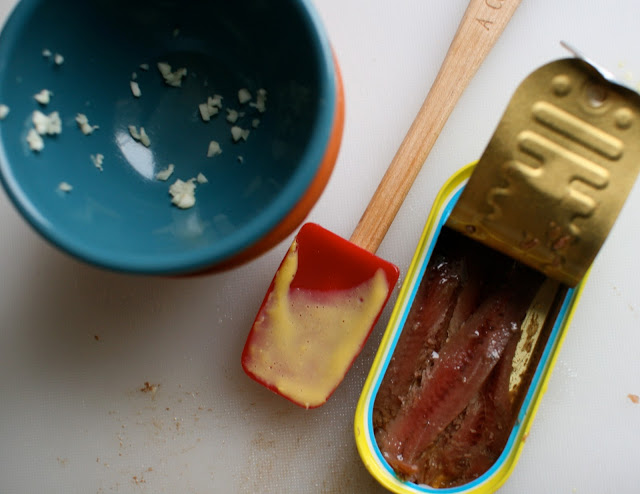I’ve started to notice that everything in China ends up taking at least three times longer than it would at home. More hoops to jump through, more people to fight through, more steps to take with everything.
For example, yesterday we had soup and salad for lunch- classic right? Clam chowder and a caesar salad just screams American, does it not? But what started as a simple idea of a soup and caesar salad lunch became a big production taking an hour+ long, starting with homemade croutons and ending with homemade dressing. The chowder I made from a can- that part took 10 minutes- so it was a satisfying semi-homemade lunch worthy of Sandra Lee’s praise.
Anyway, rather than being a pain, this actually gives me an excuse to make the things I’ve always wanted to try back home, but had been too lazy or short on time to do so. It’s easy to make homemade dressing, but even easier to run out to the corner deli to buy a bottle. I’ve especially always wanted to make my own caesar dressing, after trying a good friend’s awesomely garlicky, mayonnaisey homemade recipe a couple of years ago. The secret? According to her, lots of pressed garlic and a disgusting amount of mayonnaise. Fat and flavor, who would’ve thunk….
So herein lies hurdle number one: mayonnaise. It’s not like mayonnaise does not exist in China. But, the most common brands sold in the store are Japanese, which though tasty in their own right are worlds apart from the Hellman’s brand. American brands are generally only sold in the big, Western grocery stores and they’re three times more expensive. So in an effort to keep costs down and start my own kitchen adventure series, I decided yesterday to try my hand at making my own mayonnaise base for a caesar dressing.
While carefully selecting my eggs at the market, I realized I suddenly hit hurdle number two- raw eggs. You can make “mayonnaise” just by beating oil, but in my opinion, it’s not real mayonnaise without raw eggs. Back at home, I’ve never bought into the whole “salmonella” thing, and since I was a kid ate raw eggs with hot pot, licked fingerfuls of cookie dough, and as an adult had eggs shaken into drinks- no sweat. Here, however, as fresh as the eggs are that I buy, I still have no idea where they come from, so can’t help but imagine growing an extra arm if I eat them raw.
Luckily I encountered this article on how to pasteurize your own eggs at home for dressings and mayo. Pasteurization is the process which heats eggs and dairy to a certain temperature so as to kill the harmful bacteria which it stores, so it makes sense that this seemingly simple process can be done at home. The trick is, heating it to the proper temperature at the same time making sure you don’t cook or curdle the eggs. Most homemade processes require the use of a thermometer, but this one called for three whisks and a watchful eye. I have both.
This pasteurization uses lemon juice (or vinegar), so obviously should only be used for dressings, dips, or anything that uses raw eggs with a bit of a tangy flavor (like a pisco sour). Don’t use this in cookie dough, unless you like your sweet dough with a funky tang.

How to make Pasteurized Eggs
from About.com article
2 eggs
1 tbsp lemon juice (or white vinegar)
2 tbsp water
3 clean whisks
saran wrap
- Separate the yolk of two eggs and whisk (using the first of three whisks) in a clean glass bowl. Add 1 tbsp lemon juice and whisk again. Add 2 tbsp water and continue whisking. Once full incorporated, cover with plastic wrap and set bowl in microwave
- Microwave on high until the surface just begins to rise. After this, count eight seconds on the timer. Remove immediately, discard plastic wrap and begin to whisk egg yolk mixture with the second of your clean whisks.
- Repeat step 2 once more- set in microwave on high until surface begins to rise. After this, count eight seconds on the timer. Remove and whisk with the third of your clean whisks until egg yolk mixture is smooth and creamy.
I actually only have two real whisks, and used a pair of chopsticks as one whisk, because that’s what chinese people do (we didn’t use whisks growing up, we always use chopsticks to beat eggs. It works). Along with my mini mini whisk and my giant whisk, I had a Goldilocks and the Three Whisks situation. An odd trio, indeed.

These eggs were a great start to my mayonnaise, which in the end produced a great dressing. Since the I’m still here, with no growth of spare limbs this morning, so I’m guessing the DIY pasteurization worked.


